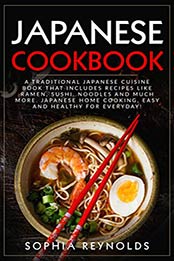
- Title: Japanese Cookbook: A traditional Japanese cuisine book that includes recipes like ramen, sushi, noodles and much more. Japanese home cooking, easy and healthy for everyday!
- Autor: Sophia Reynolds
- Pages: 180
- Publisher (Publication Date):April 4, 2020
- Language: English
- ASIN:B086SF7FPL
- Download File Format: EPUB
Food is an essential component of Japanese culture. From the specific ingredients to the overall meals they create, there are individual and particular traditions that the Japanese still practice today to create distinctive and unique dishes. Some many beliefs and customs can always be observed in Japanese cooking today and allow us to enjoy delicious recipes.
First, the Japanese believe in making food according to the season. They use ripe and primary ingredients from the current season for their cooking. For example, they highlight bamboo shoots in spring and chestnuts in fall because these are the most visible elements in those specific seasons. They also love the season they cook to reflect on their dishes. Inedible tree branches or leaves are also used to provide meals for the season. The presentation in this regard is also essential for the Japanese because Japanese chefs believe that a person must love what he sees before he consumes it.
The Japanese take it seriously to keep their bodies and minds healthy. You can see this philosophy reflected everywhere and in everything they do. For example, they think that eating slowly; estimating each portion and small portions is healthier and they avoid overeating. Traditional Japanese diets are about half of the western world’s ration and much more robust than many places around the world. The Japanese have an almost endless menu of delicious dishes.
If you like Japanese food, you should already have realized that something is different from the foods found in other countries. Yes, Japanese food is usually a light food, with no intense flavors but a taste of the foods. To add contrast to food, pure spices are often added to enhance flavors. Light dipping sauces, citrus, mousseau, wasabi, pickles and soy sauce may be included in the course.
The traditional Japanese diet is a full-fledged diet rich in fish, seafood and vegetable foods that contain small amounts of animal protein, added sugars and fats.
It is based on traditional Japanese cuisine, also known as “washoku,” which consists of small dishes of simple, fresh and seasonal ingredients.
This eating style is rich in nutrients and may provide many health benefits, including improved weight loss, digestion, longevity and better general health.
Japanese cuisine is becoming increasingly popular all over the world, due in large part to how healthy delicious Japanese meals are. The Japanese strongly believe in the saying “You are what you eat,” and they care a lot about the balance between nutrients and color in every meal.
Every region in Japan has its local specialties, as well as unique types of traditional cuisine. Usually, the conventional home-cooked Japanese meal consists of rice, miso soup and three dishes – often meat or fish and vegetables and a pickled dish – but that’s not all there is to try!
A full Japanese banquet aims to savor taste buds using a range of cooking techniques – a potential blend is a mixture of raw food, or dressed foods such as salad or cold pasta known as aimono, deep fried (agemono), steamed (mushimono)), one bowl (nabemono), boil (nimono), soup (suimonoor shirumono), vinegar (sunomono), glazed (teriyaki style) and pickled (tsukemono).
In addition to the wonderful flavor and visual beauty, it is an essential ingredient. The type of dish or dish is just as important as the food is. The Japanese have also mastered the concept of passive space, as the hollow portions of the serving.
![Japanese Cookbook for Everyday Cooking by Sophia Freeman [PDF: B08HCJ8KCH] B08HCJ8KCH](https://cookebooks.info/wp-content/uploads/2020/09/B08HCJ8KCH.jpg)
![Japanese Cookbook, 25 Delicious Japanese Recipes from Authentic Japanese Cuisine: Enjoy Authentic Japanese Meals by Ted Alling [1534823077, Format: EPUB] 1534823077](https://cookebooks.info/wp-content/uploads/2018/11/1534823077.jpg)
![Ramen for Everyone: Classic Japanese Home Cooking by Scott Erwin [1720937834, Format: EPUB] 1720937834](https://cookebooks.info/wp-content/uploads/2018/08/1720937834.jpg)
![Japanese Cookbook for Beginners recipes by Patsy B.Easton [PDF: B08HS3DJCP] Japanese Cookbook for Beginners recipes by Patsy B.Easton](https://cookebooks.info/wp-content/uploads/2020/09/B08HS3DJCP.jpg)
![Traditional Japanese Cookbook You Must Have by Molly Mills [B07S7VL78T, Format: EPUB] B07S7VL78T](https://cookebooks.info/wp-content/uploads/2019/05/B07S7VL78T.jpg)
![Japanese Cookbook by BookSumo Press [PDF: B074Z2S277] Japanese Cookbook by BookSumo Press](https://cookebooks.info/wp-content/uploads/2020/09/B074Z2S277.jpg)